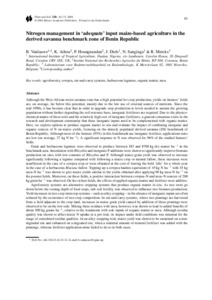| dc.contributor.author | Vanlauwe, Bernard |
| dc.contributor.author | Aihou, K. |
| dc.contributor.author | Houngnandan, P. |
| dc.contributor.author | Diels, J. |
| dc.contributor.author | Sanginga, N. |
| dc.contributor.author | Merckx, R. |
| dc.date.accessioned | 2019-12-04T11:21:14Z |
| dc.date.available | 2019-12-04T11:21:14Z |
| dc.date.issued | 2001 |
| dc.identifier.citation | Vanlauwe, B., Aihou, K., Houngnandan, P., Diels, J., Sanginga, N. & Merckx, R. (2001). Nitrogen management inadequate'input maize-based agriculture in the derived savanna benchmark zone of Benin Republic. Plant and Soil, 228(1), 61-71. |
| dc.identifier.issn | 0032-079X |
| dc.identifier.uri | https://hdl.handle.net/20.500.12478/3715 |
| dc.description.abstract | Although the West-African moist savanna zone has a high potential for crop production, yields on farmers' fields are, on average, far below this potential, mainly due to the low use of external sources of nutrients. Since the mid-1990s, it has become clear that in order to upgrade crop production to levels needed to sustain the growing population without further degrading the soil resource base, inorganic fertilizers are required. Due to the physico-chemical nature of these soils and the relatively high cost of inorganic fertilizers, a general consensus exists in the research and development community that these inorganic inputs need to be complemented with organic matter. Here, we explore options to produce organic matter in-situ and evaluate the impact of combining inorganic and organic sources of N on maize yields, focusing on the densely populated derived savanna (DS) benchmark of Benin Republic. Although most of the farmers (93%) in this benchmark use inorganic fertilizer, applications rates are low (on average, 27 kg N ha−1). A significant response to N was observed for 96% of the studied farmers' fields. Grain and herbaceous legumes were observed to produce between 383 and 8700 kg dry matter ha−1 in the benchmark area. Inoculation with Rhizobia and inorganic P additions were shown to significantly improve biomass production on sites with low contents of Rhizobia and P. Although maize grain yield was observed to increase significantly following a legume compared with following a maize crop or natural fallow, these increases were insufficient in the case of a cowpea crop or were obtained at the cost of leaving the field `idle' for a whole year in the case of a herbaceous Mucuna fallow. Topping up a cowpea haulms equivalent of 45 kg N ha−1 with 45 kg urea–N ha−1 was shown to give maize yields similar to the yields obtained after applying 90 kg urea–N ha−1 on the poorest fields. Moreover, on these fields, a positive interaction between cowpea–N and urea–N sources of 200 kg grain ha−1 was observed. On the richest fields, the effects of applied organic matter and fertilizer were additive. Agroforestry systems are alternative cropping systems that produce organic matter in-situ. As tree roots go down below the rooting depth of food crops, sub-soil fertility was observed to influence tree biomass production. Yield increases in tree-crop intercrop systems – such as alley cropping – in the absence of inorganic inputs are often reduced by the occurrence of tree-crop competition. In cut-and-carry systems, where tree prunings are harvested from a field adjacent to the crop land, increases in maize grain yield caused by addition of those prunings were observed to be on the low side. Mixing these residues with urea, however, was shown to lead to added benefits of about 500 kg grains ha−1, relative to the treatments with sole inputs of organic matter or urea. Although residue quality was shown to affect maize N uptake in a pot trial, its impact under field conditions was minimal for the range of considered residue qualities. In an alley cropping trial, maize yield was shown to be sustained on a non-degraded site and enhanced on a degraded site, when a minimal amount of mineral fertilizer was added with the prunings, whereas fertilizer application alone failed to do so in both cases. |
| dc.description.sponsorship | Directorate-General for Development Cooperation and Humanitarian Aid, Belgium |
| dc.language.iso | en |
| dc.subject | Agroforestry |
| dc.subject | Cowpeas |
| dc.subject | Cut-And-Carry Systems |
| dc.subject | Herbaceous Legumes |
| dc.subject | Organic Matter |
| dc.subject | Urea |
| dc.subject | Inorganic Fertilizers |
| dc.subject | Crop Production |
| dc.subject | Biomass |
| dc.subject | Fertilizers |
| dc.title | Nitrogen management in adequate input maizebased agriculture in the derived savanna benchmark zone of Benin Republic |
| dc.type | Journal Article |
| dc.description.version | Peer Review |
| cg.contributor.affiliation | International Institute of Tropical Agriculture |
| cg.contributor.affiliation | Institut National des Recherches Agricoles du Bénin |
| cg.contributor.affiliation | Laboratorium voor Bodemvruchtbaarheid en Bodembiologie, Belgium |
| cg.coverage.region | Africa |
| cg.coverage.region | Acp |
| cg.coverage.region | West Africa |
| cg.coverage.region | Europe |
| cg.coverage.country | Nigeria |
| cg.coverage.country | Benin |
| cg.coverage.country | Belgium |
| cg.isijournal | ISI Journal |
| cg.authorship.types | CGIAR and developing country institute |
| cg.iitasubject | Maize |
| cg.iitasubject | Smallholder Farmers |
| cg.iitasubject | Plant Breeding |
| cg.iitasubject | Agribusiness |
| cg.iitasubject | Natural Resource Management |
| cg.iitasubject | Integrated Soil Fertility Management |
| cg.iitasubject | Soil Fertility |
| cg.iitasubject | Soil Health |
| cg.iitasubject | Soil Information |
| cg.iitasubject | Crop Husbandry |
| cg.iitasubject | Farm Management |
| cg.accessibilitystatus | Limited Access |
| local.dspaceid | 95870 |

